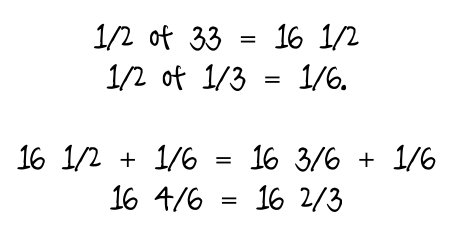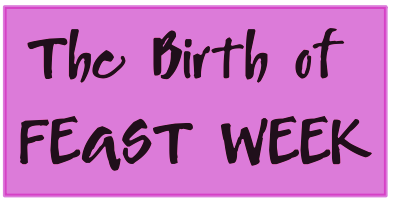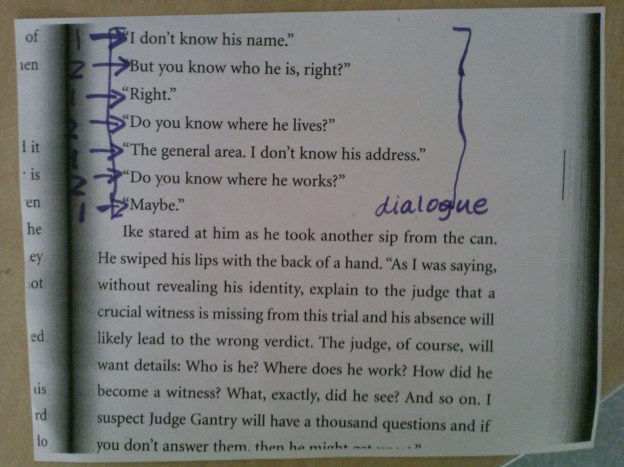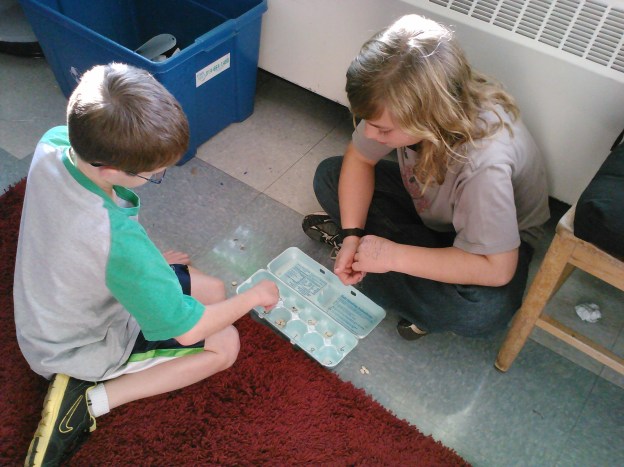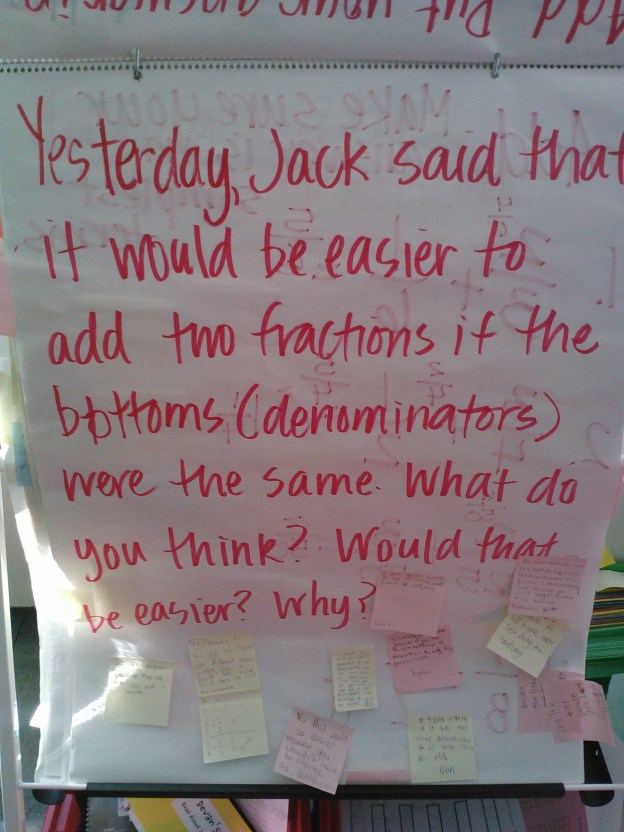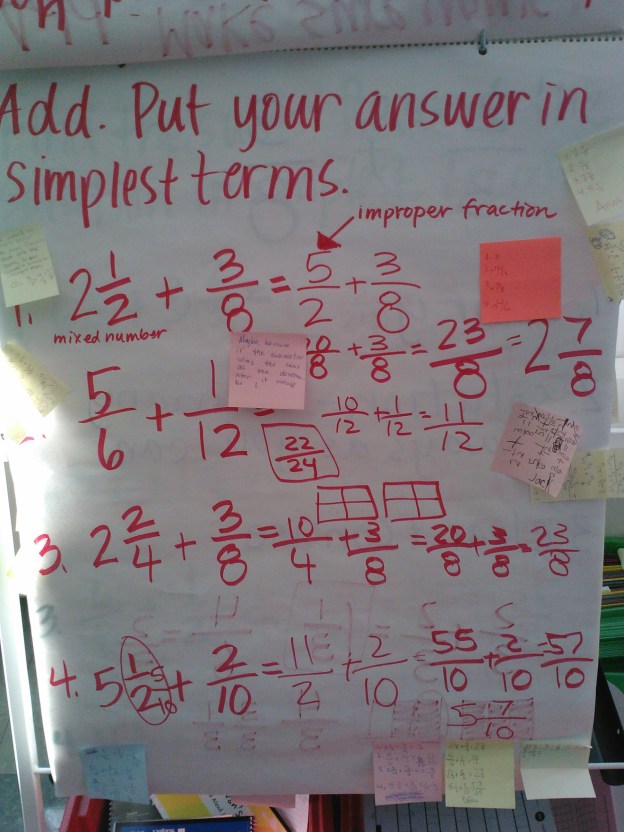In case you missed Feast Week Part 1, check it out here.
Feast Week was born, and we had decided what (and how) we were going to teach that big, deep list of concepts about fractions. We utilized the UbD template for planning the unit, focusing on what we wanted the outcomes to be and then how we’d get them there.
And then we told our kids about it. And they were BEYOND excited! We were giddy about the plan, and my students were as eager as me to start our fraction work so we could head down the road toward the beginning of the actual Feast Week. And just as we had hoped, this was just the motivation that 81 5th graders needed to get through a really hard unit on fractions.
But first we had to learn about fractions. The unit was broken down into eight big ideas:
1. What are fractions anyway?
2. How are fractions related and equivalent to percents and how can they be used to solve problems?
3. How do you find fractional parts of a group (i.e. what is 2/5 of 30 students)?
4. How do you add and subtract fractions?
5. How can you multiply a whole number by a fraction? What does it mean and why would I need to do it in real life? (As a side note: this one was cool, because it is the same as finding the fractional part of a group–they just didn’t know that back at the beginning of the unit)
6. How can you multiply a fraction by a fraction? What does it mean and why would I need to do it in real life?
7. How can you divide a whole number by a fraction? What does it mean and why would I need to do it in real life?
8. How can you divide a fraction by a whole number? What does it mean and why would I need to do it in real life?
The really fabulous (yes, I know I say that word a lot, and yes, I do it on purpose 🙂 ) thing about this unit was how many times I heard the words “Wow, this is easy!” And how surprised so many kids were that it was easy. For some reason, fractions is a four-letter-word to most people and honestly, I think that’s why so many of us (including me!) had so much trouble figuring them out.
We use Investigations as a math resource in our district, and I have always loved the way it works through math concepts–always starting with the why before showing the how. And it was no different with fractions. We did not start with straight number problems where we colored in pies that were the same amount, or with “this is the algorithm for adding fractions.” We started with the why–or the “what” really. What is a fraction, and how does it relate to percents, which are something that everyone already knows about.
Our fraction unit introduced many graphic organizers for kiddos to use to represent their math thinking, and the first one we used was a 10 by 10 grid. We used it to find fourths (again, going back to something they already know), and figured out what fractions and percents we knew from those: 1/4 is 25%, 2/4 is equivalent to 1/2 and 50%, 3/4 is 75%. Then I blew their minds when I showed them how they could find eighths on the same grid. Yep, even though 8 is not a factor of 100. Again, we had them think about what they knew and how they could use that knowledge to figure out something they didn’t know. (I’ll let you stop right now and see if you can figure out how to do it. Go ahead, I’ll even give you a 10 by 1o grid to use.)
Yeah, so I’m sure you’ve figured it out, but I’ll show you anyhow: If you find fourths, then think about what an 1/8 is. It’s half of a 1/4, right? Yep, 1/4=2/8. Since you know that 1/4 is 25%, then you can easily figure out that 1/8 is the same as 12 1/2%. Now you can use that to figure out the percent that is equivalent to any fourth or eighth, just by adding more of them. 3/8 is 37 1/2% because you know 2/8 (1/4) is 25% and then 1/8 is 12 1/2%. Crazy, right? I LOVE THIS PART!! It’s so freeing to kids who have thought all along that fractions are impossible, too hard for them, some secret that they haven’t been told. But now it’s just another puzzle–and they have the pieces to help them solve it! This fraction/percent equivalence plays a HUGE part in the whole rest of the unit, so we spend lots of time at the beginning working with those numbers in different ways to help get it sold in their minds. They had a chart they used as a resource, as well, throughout the unit. Math doesn’t have to be a mystery. It isn’t something you have to memorize. You have tools and you just have to know when and how to use them!
Another organizer we used were 4 x 6 and 5 x 12 rectangles. They’re arrays, just like the 10 x 10 grids, but work better for other numbers that have factors like 3, 4, 5 and 6 (thirds, fourths, fifths, sixths, etc.). We could use them to find the fractional parts of almost any number that way.
These were used when we moved on to finding thirds and sixths (which you can do with percents, as well, too). These were cool, too, when they figured out that 1/3 was 33 1/3% and that 1/6 is half of that. That’s a crazy question: what is 1/2 of 33 1/3? Wish I would have recorded them figuring out that it’s 16 2/3%. Really. It is. Try it. Here, let me show you:
The first time I did that it heard my head. The second and third times it did, too. Yeah, I’ll admit it. Some of the things I ask my kids to do seemed crazy in the beginning. Mainly because it’s not how I learned it, but this time around it totally makes sense. I wonder what it would have been like to do math like this when I was a kid…
(Ready for Part 3? Find it here.)





